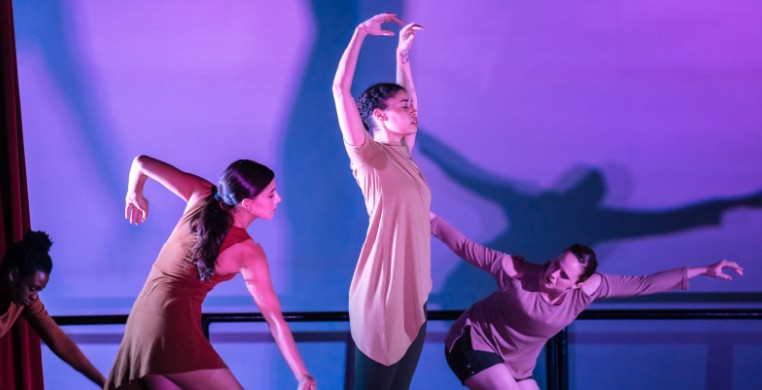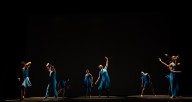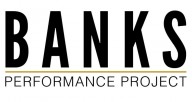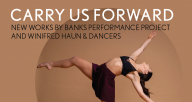In the lobby of the Hamilton Park Cultural Center, a river of bodies flows down a pair of symmetrical stone staircases, pooling into a high-ceilinged foyer, spilling into the astonished audience. They play with the onlookers, one dancer languidly unfurling their arms mere inches from my face. These sprites are then whisked away towards a large double door and into a dark room, an auditorium with a blonde wood floor and a stage, a white proscenium framing a turquoise and lavender background. Caught in the rush of the current we follow them.
This welcoming display, titled “Leveled,” is our introduction to “Carry Us Forward,” a performance of new work and repertory, composed collaboratively and unilaterally by Banks Performance Project and Winifred Haun & Dancers. Once inside the auditorium, we are greeted by the directors of both companies, Elysia C. Banks and Winifred Haun, and each give a polite speech containing background information on the program. As if to justify the performance, Haun ends a series of acknowledgements with an apothegm, saying that “The art of creation is a victory… Every victory—no matter how small—sets us up for the next victory.”
The program continues with a short solo, titled “Disquiet,” by Banks and performed by Natalie Dellutri, who delicately chassés across the floor as a large projection of her own silhouette looms in the background, like a puppet master pulling the strings of a dancing harlequin. Near the end, Dellutri’s lightness cracks a little and she loses some of her weightlessness. Steps become heavy and audible. An unseen force grabs her by the wrists and several times tries to pull her violently upward (the shadow?). As a preface to a story, the question of “Who is in control” is set up in “Disquiet” and is answered in the following piece.
“When Day Comes, part 1 & 2),” choreographed by Haun, begins with a solitary figure, her arms fanning high overhead, then swept across the floor, correlating with soft piano chords and the sounds of airy “whooshes” and heavy breathing. The company of seven dancers are soon bewitched by a sorceress trailed by a long, stretchy ribbon of fabric—the source of her power? The sorceress is in control, who extending her ribbon to maximum tautness as her subjects bring pointed toes to a high passé above their knee. When left to their own devices, the assemblage moves through a variety of abstract scenes taken from life: To the song “Fever” by Peggy Lee, a nervous couple goes from barely being able to hold hands to taking running leaps into each other’s arms. Six bodies float, fold, morph and tumble around each other like amoebas in a petri dish, climbing on top of and being absorbed into one another. But the sorceress has had enough! With hands held high, she raises her enchanted ribbon above her head, preparing to bring down elemental forces on those brave but cowering before her, and then… BLACKOUT!
“Loss One” is a solo work choreographed and performed by Vernon Gooden with music by Terence Trent. Gooden is tangibly affected by accents in the music. Ripples in the percussion cause a corresponding mini-avalanche throughout the body. A gust of pleasant harmonies lift his arms up in a “Y” and spin him like a bird turning mid-flight. At times there is an adherence to strict lyricism—arms spread wide at a spoken “Confirmed, we are here!” Other times, there is a distinct anti-lyricism—Gooden smiles at “Fear is our enemy.” The piece ends abruptly as Gooden loses all tensions in his hands and head, a smirk on his face, and casually walks offstage, just as the piece was warming up.
“7 Years” by Banks consists of a trio of dancers in brown, purple, grey, in a display of shifting movement styles and techniques. Sometimes there are visual archetypes imposed, like eating an apple, or the drawing of a bow. Interaction is predominant in the work. There are some grand gestures, like the body of one being lifted by the others in a horizontal Superman pose then smoothly spun around. There are technical tidbits to enjoy, such as a series of sharp, staccato movements originating at the joints, or a Martha Graham-inspired lunging with palm-to-forehead lamentation. “7 Years” is a work of pure expression that does not overload the senses or overstay it’s welcome.
“Two Forward, One Back” is a romantic duet by Mandy Milligan and features Crustal Gurrola and Jacinda Ratcliffe. Dressed in elegant flower-patterned dresses, the sound of popping champagne bottles elicits a series of statuesque poses—standing, knees bent, legs apart, hands over eyes—but the spell is broken as one crushes an imaginary bottle in her hand, with accompanying sound effect, and the pair drop to the floor and roll over each to the sounds of broken glass being crushed. Upon recovery, the two proceed to float around each other, like petals on a breeze, or two boozy-buddies leaning on the other and stumbling home. “Two Forward, One Back” succeeds as a tender tale of companionship that is light, airy and enjoyable.
“Bento” (2011) by Winifred Haun and featuring the dancers in her company is constructed around a series of movement motifs that are developed and explored. Pay attention! Because the beginning foreshadows the end. Some of the motifs are: A series of light toe taps lead to a springy jump with a kick. Three short jumps bring the arms and legs together. Spinning arms send their momentum to a short backwards développé in one leg to the back corner. Midway, they all breakaway from the repetition, a moment of chaos that has them running in a wide circle, branching out into their own orbits, spinning around like unbonded molecules. But they soon re-congeal. As they come together at the end, the beginning motifs are done in tandem by all dancers, resembling the working viscera of a large, see-through organism, each one doing their job separately but towards the same goal.
A couple years ago, everyone was speculating on what the dance scene would be like as the world becomes reaccustomed to live entertainment following the COVID pandemic. “Carry Us Forward” is an optimistic example of that world. Sure, dance companies teaming up to put on a show is nothing revolutionary, but it was the words of Haun and Banks during their brief introduction that made it feel different. I could hear the thankfulness in the tone of their voices, thankful to have emerged from a catastrophe that cared not for pedigree or length of time in the business. They’re here. Others are not. I try not to dwell on that fact, but the more I think about it, the more I suggest an amendment to Haun’s apothegm—Every victory, no matter how small, is still big.




